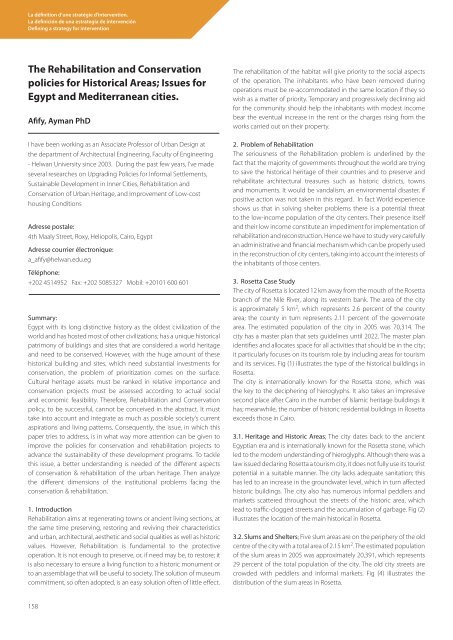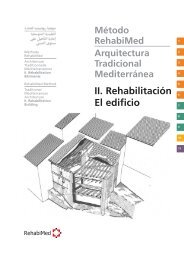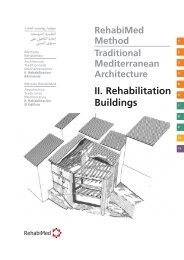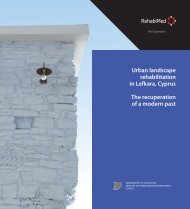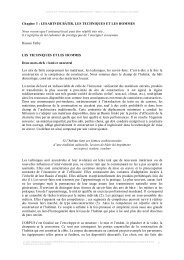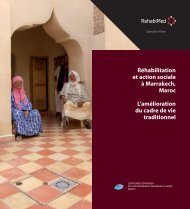La définition d'une stratégie d'intervention. La ... - RehabiMed
La définition d'une stratégie d'intervention. La ... - RehabiMed
La définition d'une stratégie d'intervention. La ... - RehabiMed
You also want an ePaper? Increase the reach of your titles
YUMPU automatically turns print PDFs into web optimized ePapers that Google loves.
<strong>La</strong> <strong>définition</strong> d’une <strong>stratégie</strong> d’intervention.<br />
<strong>La</strong> definición de una estrategia de intervención<br />
Defining a strategy for intervention<br />
The Rehabilitation and Conservation<br />
policies for Historical Areas; Issues for<br />
Egypt and Mediterranean cities.<br />
Afify, Ayman PhD<br />
I have been working as an Associate Professor of Urban Design at<br />
the department of Architectural Engineering, Faculty of Engineering<br />
- Helwan University since 2003. During the past few years, I’ve made<br />
several researches on Upgrading Policies for Informal Settlements,<br />
Sustainable Development in Inner Cities, Rehabilitation and<br />
Conservation of Urban Heritage, and Improvement of Low-cost<br />
housing Conditions<br />
Adresse postale:<br />
4th Maaly Street, Roxy, Heliopolis, Cairo, Egypt<br />
Adresse courrier électronique:<br />
a_afify@helwan.edu.eg<br />
Téléphone:<br />
+202 4514952 Fax: +202 5085327 Mobil: +20101 600 601<br />
Summary:<br />
Egypt with its long distinctive history as the oldest civilization of the<br />
world and has hosted most of other civilizations; has a unique historical<br />
patrimony of buildings and sites that are considered a world heritage<br />
and need to be conserved. However, with the huge amount of these<br />
historical building and sites, which need substantial investments for<br />
conservation, the problem of prioritization comes on the surface.<br />
Cultural heritage assets must be ranked in relative importance and<br />
conservation projects must be assessed according to actual social<br />
and economic feasibility. Therefore, Rehabilitation and Conservation<br />
policy, to be successful, cannot be conceived in the abstract. It must<br />
take into account and integrate as much as possible society’s current<br />
aspirations and living patterns. Consequently, the issue, in which this<br />
paper tries to address, is in what way more attention can be given to<br />
improve the policies for conservation and rehabilitation projects to<br />
advance the sustainability of these development programs. To tackle<br />
this issue, a better understanding is needed of the different aspects<br />
of conservation & rehabilitation of the urban heritage. Then analyze<br />
the different dimensions of the institutional problems facing the<br />
conservation & rehabilitation.<br />
1. Introduction<br />
Rehabilitation aims at regenerating towns or ancient living sections, at<br />
the same time preserving, restoring and reviving their characteristics<br />
and urban, architectural, aesthetic and social qualities as well as historic<br />
values. However, Rehabilitation is fundamental to the protective<br />
operation. It is not enough to preserve, or, if need may be, to restore; it<br />
is also necessary to ensure a living function to a historic monument or<br />
to an assemblage that will be useful to society. The solution of museum<br />
commitment, so often adopted, is an easy solution often of little effect.<br />
The rehabilitation of the habitat will give priority to the social aspects<br />
of the operation. The inhabitants who have been removed during<br />
operations must be re-accommodated in the same location if they so<br />
wish as a matter of priority. Temporary and progressively declining aid<br />
for the community should help the inhabitants with modest income<br />
bear the eventual increase in the rent or the charges rising from the<br />
works carried out on their property.<br />
2. Problem of Rehabilitation<br />
The seriousness of the Rehabilitation problem is underlined by the<br />
fact that the majority of governments throughout the world are trying<br />
to save the historical heritage of their countries and to preserve and<br />
rehabilitate architectural treasures such as historic districts, towns<br />
and monuments. It would be vandalism, an environmental disaster, if<br />
positive action was not taken in this regard. In fact World experience<br />
shows us that in solving shelter problems there is a potential threat<br />
to the low-income population of the city centers. Their presence itself<br />
and their low income constitute an impediment for implementation of<br />
rehabilitation and reconstruction. Hence we have to study very carefully<br />
an administrative and financial mechanism which can be properly used<br />
in the reconstruction of city centers, taking into account the interests of<br />
the inhabitants of those centers.<br />
3. Rosetta Case Study<br />
The city of Rosetta is located 12 km away from the mouth of the Rosetta<br />
branch of the Nile River, along its western bank. The area of the city<br />
is approximately 5 km 2 , which represents 2.6 percent of the county<br />
area; the county in turn represents 2.11 percent of the governorate<br />
area. The estimated population of the city in 2005 was 70,314. The<br />
city has a master plan that sets guidelines until 2022. The master plan<br />
identifies and allocates space for all activities that should be in the city;<br />
it particularly focuses on its tourism role by including areas for tourism<br />
and its services. Fig (1) illustrates the type of the historical buildings in<br />
Rosetta.<br />
The city is internationally known for the Rosetta stone, which was<br />
the key to the deciphering of hieroglyphs. It also takes an impressive<br />
second place after Cairo in the number of Islamic heritage buildings it<br />
has; meanwhile, the number of historic residential buildings in Rosetta<br />
exceeds those in Cairo.<br />
3.1. Heritage and Historic Areas; The city dates back to the ancient<br />
Egyptian era and is internationally known for the Rosetta stone, which<br />
led to the modern understanding of hieroglyphs. Although there was a<br />
law issued declaring Rosetta a tourism city, it does not fully use its tourist<br />
potential in a suitable manner. The city lacks adequate sanitation; this<br />
has led to an increase in the groundwater level, which in turn affected<br />
historic buildings. The city also has numerous informal peddlers and<br />
markets scattered throughout the streets of the historic area, which<br />
lead to traffic-clogged streets and the accumulation of garbage. Fig (2)<br />
illustrates the location of the main historical in Rosetta.<br />
3.2. Slums and Shelters; Five slum areas are on the periphery of the old<br />
centre of the city with a total area of 2.15 km 2 . The estimated population<br />
of the slum areas in 2005 was approximately 20,391, which represents<br />
29 percent of the total population of the city. The old city streets are<br />
crowded with peddlers and informal markets. Fig (4) illustrates the<br />
distribution of the slum areas in Rosetta.<br />
158


